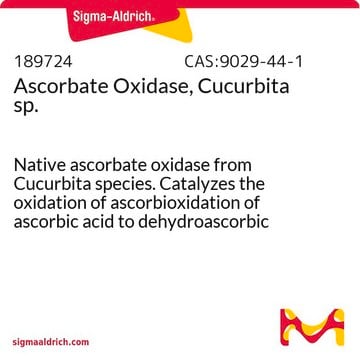261556
(L)-Dehydroascorbic acid
Synonym(s):
DHAA, Dehydro-L-ascorbate, Dehydro-L-ascorbic acid, L-threo-Dehydroascorbic acid, oxidized ascorbic acid, oxidized vitamin C
About This Item
Recommended Products
form
powder
mp
228 °C (dec.) (lit.)
storage temp.
−20°C
SMILES string
OC[C@H](O)[C@H]1OC(=O)C(=O)C1=O
InChI
1S/C6H6O6/c7-1-2(8)5-3(9)4(10)6(11)12-5/h2,5,7-8H,1H2/t2-,5+/m0/s1
InChI key
SBJKKFFYIZUCET-JLAZNSOCSA-N
Looking for similar products? Visit Product Comparison Guide
General description
DHA is a dimer when it is solid, but when it is dissolved in a solution, it becomes a monomer.
Application
- Pyrano[3,4-b]indole derivatives by reacting with 2-hydroxymethylindole.
- (−)-ascorbyl phloroglucinol via stereoselective C-C bond formation reaction with phloroglucinol.
Storage Class Code
11 - Combustible Solids
WGK
WGK 3
Flash Point(F)
Not applicable
Flash Point(C)
Not applicable
Personal Protective Equipment
Certificates of Analysis (COA)
Search for Certificates of Analysis (COA) by entering the products Lot/Batch Number. Lot and Batch Numbers can be found on a product’s label following the words ‘Lot’ or ‘Batch’.
Already Own This Product?
Find documentation for the products that you have recently purchased in the Document Library.
Customers Also Viewed
Articles
Simultaneous analysis of ascorbic acid and dehydroascorbic acid in various food samples by High Performance Thin Layer Chromatography (HPTLC).
Our team of scientists has experience in all areas of research including Life Science, Material Science, Chemical Synthesis, Chromatography, Analytical and many others.
Contact Technical Service









